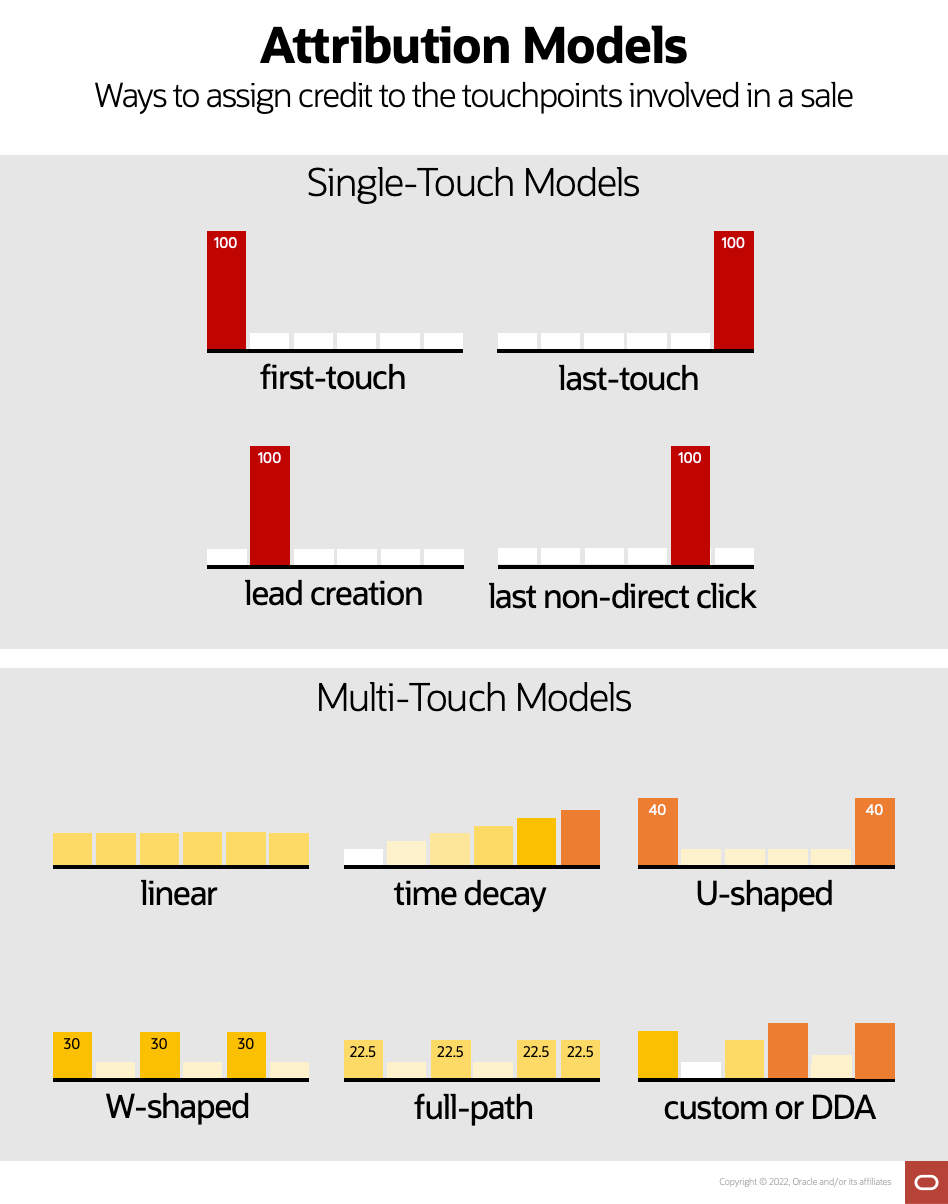Giving 100% of the credit for a sale to the channel that either attracted the customer by generating the first click of an interaction or closed the deal by producing the last click made sense in the early early ’00s when the average consumer used two touchpoints when buying an item. However, consumers today use an average of around six touchpoints, according to research by Aberdeen, Oracle, and Relationship One.
In our omnichannel world, single-touch attribution is simply too out of sync with consumer behavior. To appropriately attribute marketing activity today requires use of a multi-touch attribution model, of which there are many. Each assigns different weights to different points in a customer journey, with some of the more important ones being:
- The first touch, when the prospect becomes aware of your brand
- Marketing qualified lead creation, when the prospect provides their contact information in a form and marketing communications begin
- Sales qualified lead creation, when the sales team determines that the prospect is a potential customer
- Opportunity-creation, when a prospect signals that they’re open to buying
- The last touch, when the prospect makes their purchase
Learn how to bridge the gap between sales and marketing by using Oracle Fusion Marketing to automate lead scoring and pass opportunities more likely to result in revenue to sales.
Multi-Touch Attribution Models
Let’s discuss the various models you could adopt, including the pros and cons, so you can determine which might be the best for your business.
Linear attribution. This model gives equal credit to all touchpoints involved. While simple and egalitarian, it likely doesn’t truly represent the role of each touchpoint in your buyers’ journeys. For that reason, many organizations are moving away from this approach as it has become even more apparent that it is not reflective of the connected customer ecosystem.
Time decay attribution. This model gives more credit to the most recent touchpoints. Devaluing top-of-the-funnel interactions, this model is most appropriate for organizations with long sales cycles, such as B2B companies selling expensive software or equipment.
U-shaped attribution. A kind of position-based attribution, this model assigns 40% of the sale to the first touchpoint and 40% to the last, and then evenly shares the remaining 20% among the touchpoints in between.
W-shaped attribution. Another kind of position-based attribution, this model assigns 30% of the sale to the first touchpoint, 30% to the touchpoint that creates the lead, 30% to the touchpoint that creates the opportunity, and 10% to the remaining touchpoints. This model is appropriate for many B2B sales processes, particularly ones with a heavy request for proposal (RFP) process that turns leads into opportunities.
Full-path attribution. Yet another kind of position-based attribution, this model assigns 22.5% of the sale to the first touchpoint, 22.5% to the touchpoint that creates the lead, 22.5% to the touchpoint that creates the opportunity, 22.5% to the last touchpoint, and the remaining 10% to all other touchpoints in the journey.
Custom attribution. In this model, you assign your own weights to each of the touchpoints. This allows organizations to tailor a model to how their business operates and how their prospects behave.
For example, companies intrinsically know that a prospect attending a 4-hour in-person event is more impactful than a prospect attending a 1-hour webinar, which is in turn more impactful than a prospect downloading a 5-page whitepaper. Custom attribution allows brands to assign higher weights to more expensive activities that they know result in higher impacts.
Organizations should also feel free to tweak any of the standard attribution models discussed above to fit their purposes. For instance, one client of ours used a modified U-shaped model where they assigned one-third of the sale value to the first touch and two-thirds to the last touch.
Data-driven attribution. In this model, machine learning assigns the credit to the various touchpoints in a customer journey. Generally speaking, it does this by comparing the paths of customers with those who didn’t convert to determine which touchpoints are more valuable than others in terms of putting prospects on the path to a sale.
Which of those multi-touch models is right for you? It depends. And, unfortunately, these decisions aren’t just about the cold hard numbers. They’re also about…
The Politics of Multi-Touch Attribution
When companies change their attribution model, they’re changing the value they assign to various channels and touchpoints—and the value of the people that work on those. That makes attribution decisions as much about people and politics as it does about customer behaviors and math. So, even if you’re changing from a model that clearly isn’t aligned with reality, be prepared for pushback.
Here are three ways you can smooth a transition to a new multi-touch attribution model:
1. Ensure that all impacted parties have a seat at the table. You can only make an honest attempt at getting organization-wide buy-in on changes if everyone is invited to the attribution discussion. That gives all parties a chance to voice their concerns and be heard, as well as to hear the concerns of everyone else.
2. Communicate new reporting clearly. Once an attribution model or set of models have been defined for your business, ensure all parties understand them, when and why they are used and their benefits and downfalls. Doing so enables decision-makers and leaders to frame up results or reporting in a way that’s relevant to their department.
3. Acknowledge that no attribution model is perfect. Your leadership should acknowledge that there are tons of factors that drive revenue from different departments that will never show up in any attribution model. They should look for alternative ways to value departments that have difficult-to-measure revenue impacts, but are clearly important.
One way to help avoid confusion is to work with your analyst team to pre-build reporting templates to measure success for various business units, departments, campaigns, etc. That ensures your analytics and attribution models are used properly.
Organizations should also consider supporting additional attribution models that they don’t use for budgeting purposes. That’s because various channels and touchpoints can learn from different models. For example, mid-funnel channels can learn a lot from W-shaped attribution models that allow them to see potential opportunities even if the company as a whole wants to exclusively use a U-shaped model for its budgeting purposes. This willingness to support additional attribution models should also extend to single-touch models.
How Best to Use First- and Last-Touch
Single-touch attribution models like first- and last-click attribution still have their place and should still be measured. But they should primarily be used to identify optimization opportunities.
For example, using first-touch attribution focuses your attention on those channels and touchpoints that excel at first impressions, building brand awareness, and generating initial interest—like email marketing. Knowing that allows you to optimize those touchpoints to perform that role even better and to perhaps focus more of your advertising efforts on driving prospects and cold leads toward those touchpoints.
On the other hand, using last-touch attribution focuses your attention on those channels and touchpoints that excel at closing the sale. Knowing that, you can optimize these touchpoints on appealing to that knowledgeable, high-intent prospect.
However, when you’re looking for an attribution model to help your organization properly allocate budget dollars to your various touchpoints, multi-touch attribution models are the best option to stay aligned with today’s omnichannel consumers.
—————
Need help refining your attribution modeling? Oracle Digital Experience Agency has hundreds of marketing and communication experts ready to help Responsys, Eloqua, Unity, and other Oracle customers create stronger connections with their customers and employees—even if they’re not using an Oracle platform as the foundation of that experience. With a 94% satisfaction rate, our clients are thrilled with the award-winning work our creative, strategy, and other specialists do for them, giving us an outstanding NPS of 82.
For help overcoming your challenges or seizing your opportunities, talk to your Oracle account manager, visit us online, or email us at OracleAgency_US@Oracle.com.
To stay up to date on customer experience best practices and news, subscribe to Oracle Digital Experience Agency’s award-winning, twice-monthly newsletter. View archive and subscribe →


